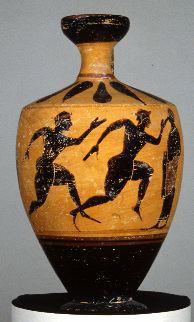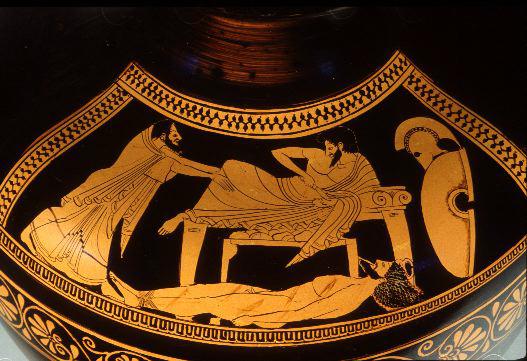





Frequently Asked Questions about the Ancient Olympic Games
- Where did the Olympic games come from?
- Why were they held at Olympia?
- Were there other contests like the Olympics?
- Who could compete in the Olympics?
- Were women allowed at the Olympics?
- How were the athletes trained?
- What prizes did Olympic victors get?
- Who were the Olympic judges?
- What was the penalty for cheating?
- Where did the marathon come from?
- When did the ancient games begin and when did they end?
Where did the Olympic games come from?

Overview: handle to rear
Photograph by Maria Daniels, courtesy of The University of Pennsylvania Museum of Archaeology and Anthropology
There are many different stories about the beginning of the Olympics.

Photograph by Michael Bennett
One myth says that the guardians of the infant god Zeus held the first footrace, or that Zeus himself started the Games to celebrate his victory over his father Cronus for control of the world. Another tradition states that after the Greek hero Pelops won a chariot race against King Oenomaus to marry Oenomaus's daughter Hippodamia, he established the Games.

Side A: enthroned Zeus, from the knees up
Photograph by Maria Daniels, courtesy of Harvard University Art Museums
Athletic games also were an important part of many religious festivals from early on in ancient Greek culture. In the Iliad, the famous warrior Achilles holds games as part of the funeral services for his best friend Patroclus. The events in them include a chariot race, a footrace, a discus match, boxing and wrestling.

Shoulder: ransom of Hector
Photograph by Maria Daniels, courtesy of Harvard University Art Museums
The footrace was the sole event for the first 13 Olympiads. Over time, the Greeks added longer footraces, and separate events. The pentathlon and wrestling events were the first new sports to be added, in the 18th Olympiad.
To read more about these topics, see Further Resources.
This exhibit is a subset of materials from the Perseus Project database and is copyrighted.